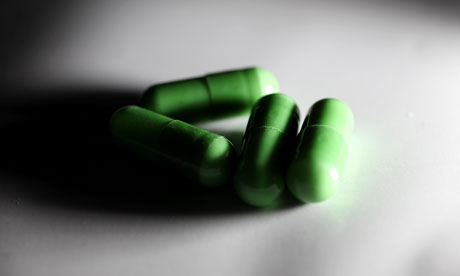
Drugs 2.0: The Web Revolution That's Changing How the World Gets High
by Mike Power 300pp, Portobello, £14.99
The real-world equivalent of Breaking Bad's crystal-meth cook, Walter White, is not a disaffected former school science teacher but a Chinese chemistry graduate in his mid-30s. He sits in his Shanghai lab beneath shelves of liquor and cigars, wears designer clothes, and drives a shiny American SUV. You can email him the chemical formula for a new drug, and his assistants will synthesise it and post it to you. And then you can get completely off your face.
As Mike Powers's fascinating and vividly written book shows, new drugs are invented every year to circumvent current bans, and freely sold on the internet. It doesn't take much extrapolation from current tech trends to see where this will eventually end up. Once we all get atomic-level 3D printers, we can just build our own pills at home. Then "controlled substance" will finally be completely uncontrollable.
You could try, instead, to control information. The organic chemistry is bona fide scientific research, but even so, many of the current drug wars are information wars. Power documents the rise of websites on which communities of psychonauts report on their experiences with certain compounds, or rate the reliability of internet sellers. (Such sites indubitably save lives.) Drug users know that official drug advice – for example, the UK government's Talk to Frank helpline – is condescending and unreliable. In any case, Power points out, "people are taking more drugs than the authorities even know exist, in ways they would not believe".
Meanwhile, an American law that bans not only current compounds but their possible chemical cousins criminalises not the possession or sale of a new compound, but the supply of information along with it – information about the drug's effects and safe dosage. This makes drug-taking more dangerous. Power concludes that the greatest threat to users is that of mislabelling. If we were sad to discover that our horsemeat had been labelled "beef", spare a thought for the person ordering a trippy powder that is mistakenly described as 10 times less potent. He will take 10 times as much as is safe, and overdose, possibly fatally.
The new designer drugs – or, as the wryly exploratory users' lingo has it, "research chemicals" – are invented by slightly altering the formula for known molecules such as MDMA (ecstasy), ketamine, LSD and so on. A famous recent example was mephedrone, or "meow meow", cooked up in response to "a global MDMA shortage" after a large quantity of safrole oil (a precursor chemical used to make ecstasy) was seized by the UN in Cambodia in 2008. Mephedrone became hugely popular during its window of legality, before the usual fear-mongering denunciations by politicians and the media, and the usual ban. And what does a ban do? As Power argues, it drives users to experiment with another new chemical that is not yet illegal, whose effects might be less well understood.
The book ends with a description of the modern internet drug scene, conducted on encrypted network Tor and using Bitcoin as its currency, along with a survey of anti-prohibition developments around the world. (The presidents of Guatemala and Colombia have talked about legalisation; Portugal decriminalised all drugs including heroin in 2001 and now has half as many "problem drug users" and half as many people injecting smack.) Power is clear that current policy massively amplifies the harm suffered by users and others. His is an informed and thoroughly hip intervention into a public debate that is too often evidence-hostile and tabloid-panderingly disingenuous.
But it's not just techy and wonkish; Power's book is funny as well. As with any realm of intellectual creativity, the world of "research chemicals" has its revered geniuses. Alexander Shulgin, "the world's most prolific and genius-tinged psychedelic chemist", is one. Shulgin created ecstasy, and "pioneered the concept of the 'museum dose' – a quantity of a drug that he deemed appropriate for trips to interesting exhibitions". Another is a retired professor of organic chemistry, John William Huffman: "This elderly gentleman," Power writes, "with his tidy beard, plain spectacles and owlish manner, is responsible for getting thousands of people incapably stoned." Huffman conducted research on synthetic cannabinoids, for the sake of "pure science"; now they are being made in significant quantities. "The synthetics are much more dangerous," Huffman tells Power. "No one has ever died of an overdose of marijuana. You'd probably forget where you put the stuff."
Like any field of commerce, legal or otherwise, "research chemicals" depend on clever marketing. "Legal highs" have often been sold under the deadpan rubric of "bath salts" or "plant food"; and it's important to give a new chemical a pronounceable brand name.
"In the same way that 3,4-methylenedioxy-N-methylamphetamine only really took off when it became known as ecstasy," Power explains, "and just as 4-methyl methcathinone became much more popular once it was called 'meow', so too did 6-(2-aminopropyl)benzofuran, AKA 6-APB, gain many more fans when it became branded as Benzo Fury."
Power quotes liberally from users' forthright field reports. One person writes approvingly of a new chemical that is like "cocktail-party MDMA"; another describes an experience on a slightly altered version of a popular animal tranquilliser: "It felt like a really pointless version of ketamine: no psychedelic effects, no pleasant slide into rubbery nonsense, just a sudden drop off the cliff of wrongness." If the government helplines spoke like that, perhaps more people would listen.
• Steven Poole's You Aren't What You Eat is published by Union Books.

